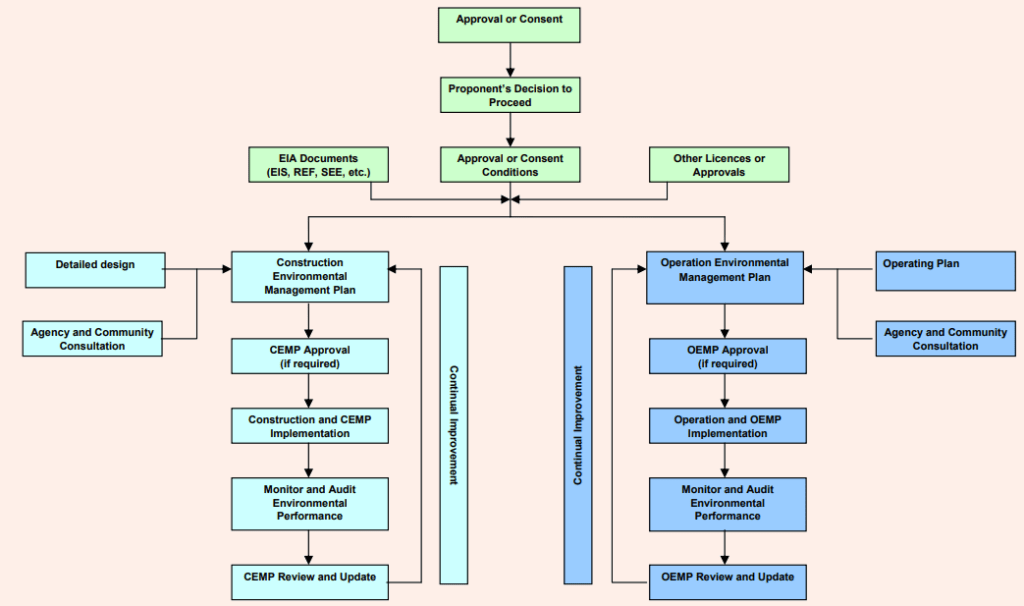The primary objective of the EMP is to provide information to the Authority on a proposed/existing activity within the regional or local framework. The plan highlights on how the proposed/existing activity may influence on the relevant environmental factors and how those impacts may be alleviated and managed to be environmentally acceptable.
Objectives of Environmental Management Plan (EMP):
The objectives of the EMP are to:
- Place the proposed/existing activity in the context of the local and regional environment
- Sufficiently describe all components of the proposed/existing activity, so that the authority can consider approval of a well-defined project
- Identify the environmental issues/risks corresponding with the proposed/existing activity.
- Provide the basis of the proponent’s environment management program, which shows that the environmental Impacts resulting from the proposed/existing activity, including cumulative impact, can be acceptably managed and
- Provide a document that clearly sets out the reasons why the proposed/existing activity should be judged by the Authority to be environmentally acceptable.
The EMP pays attention to the existing social and physical infrastructure in and around the proposed project. It applies Omani legislation, SEU guidelines, Equator Principles and World Bank International agreements and the requirement of Orpic as a minimum.
The EMP for the operation and construction phases of the project follows the ‘Plan-Do- Check-Act’ system in line with the ISO 14001 EMS guidelines and includes the organization structure, resources, responsibilities, control and mitigation measures, monitoring/auditing programs, systems for review and implementation of corrective actions.
Why Prepare an Environmental Management Plan (EMP) ?
EMP are valuable tools to:
- Define details of who, where, what, and When environmental management and mitigation measures are to be executed
- Provide legal bodies and /Company and their contractors, developers and other stakeholders better on-site environment management control over the life of a project
- Allow Project advocate/defender to ensure their contractors fulfill environmental obligations on their behalf , and
- Demonstrate due diligence.
In addition, EMPs are often required as part of tendering for projects and are essential for some types of government projects
Types of Environmental Management Plan (EMP)
EMPs can be prepared at various times in a project’s life cycle. Usually these are prepared as:
- Construction EMPs ( CEMP)
- Operation EMPs ( OEMP)
And in some countries
- Decommissioning /Demolition EMPs ( DEMP)
After procuring project Environmental Permit Clearance; the following details CEMP & OEMP process:

Figure: CEMP & OEMP Process
Structure of CEMP
The CEMP will contain the following sections, as minimum:
- Introduction;
- Objectives and Structure of the CEMP;
- Legal and Regulatory requirements
- Roles and Responsibilities
- Overview of the Project development;
- Baseline environmental conditions
- Details of the construction activities with statement of work methods;
- Tabulated list of identified environmental aspects and impacts;
- Corrective actions/measures to control and manage the identified impacts related to the construction activities;
- Observing methodology, list of environmental quality parameters and the frequency of sampling or scope of monitoring;
- Incident/emergency preparedness and response;
- Data management and reporting; and
- Statement of responsibilities, whether separately or jointly, of contractors, consultants and/or the Project’s owner.
Structure of OEMP
This Operational Environmental Management Plan (OEMP) addresses environmental issues corelated with the operation and maintenance of the project. The OEMP will contain the following sections as a minimum;
- Introduction;
- Objectives and Structure of the OEMP;
- Legal and Regulatory requirements
- Roles and Responsibilities
- Environmental management structure
- Non-conformance control, corrective and preventative action
- Environmental training and induction.
- Internal communication
- Community complaints
- Emergency/ Incident planning and response
- Environmental audit and inspection program
- Document control and review
- Management of mitigation measures and monitoring requirements.
